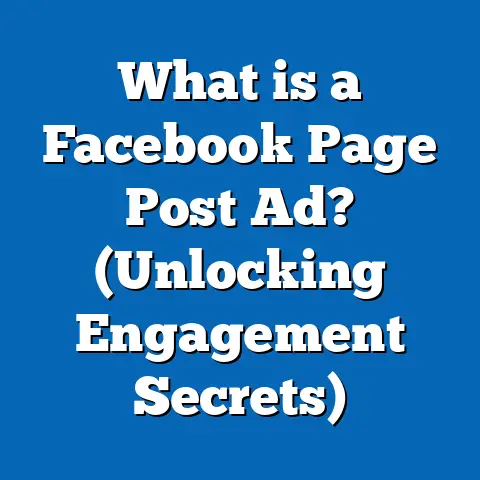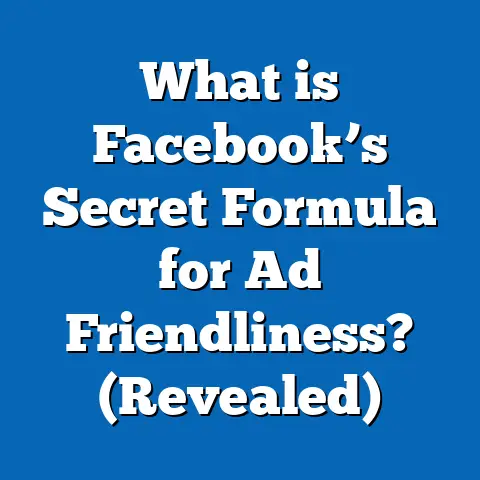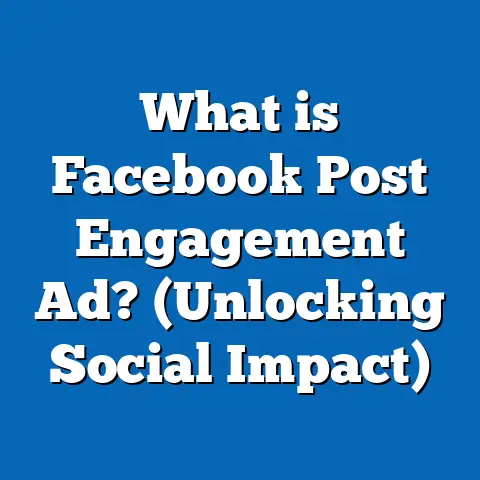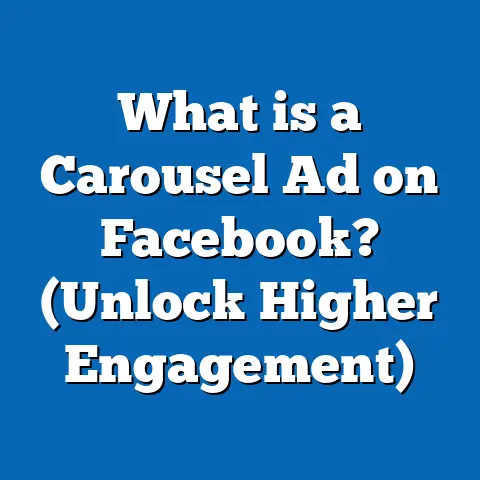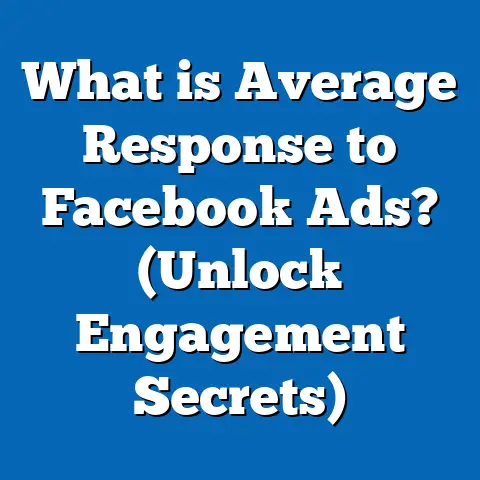What is Facebook Automated Ads? (Unlocking Smart Campaigns)
Introduction: The Resale Value of Smart Advertising
In the world of business, resale value is a critical factor when investing in any asset. While resale value traditionally applies to physical goods—like cars, real estate, or electronics—the concept can also be applied metaphorically to intangible assets like advertising strategies. Just as a high-resale-value product retains worth over time, effective marketing campaigns can generate ongoing customer engagement, brand loyalty, and sales long after their initial launch. When companies invest in advertising that is smart, adaptive, and data-driven, they build a foundation that keeps delivering returns.
Facebook Automated Ads, also known as Smart Campaigns, represent this kind of intelligent investment in advertising. They are designed to generate optimized results through automation and artificial intelligence (AI), reducing wasted spend and improving targeting precision. This guide will explore how Facebook Automated Ads work, why they matter in 2025’s digital marketing landscape, and how marketers can leverage them to maximize their advertising resale value—ensuring campaigns remain relevant, efficient, and profitable over time.
Understanding Facebook Automated Ads
What Exactly Are Facebook Automated Ads?
Facebook Automated Ads are a streamlined form of Facebook advertising where much of the campaign setup and optimization process is automated. Instead of advertisers manually selecting detailed audience segments, placements, and bidding strategies, Facebook’s AI uses historical data and machine learning to:
- Select the best audience.
- Choose optimal placements across Facebook’s platforms.
- Allocate budget dynamically.
- Test multiple ad creatives automatically.
The goal is to simplify ad creation for small to medium-sized businesses or marketers who lack dedicated ad management resources while maximizing campaign impact.
How Do Smart Campaigns Differ from Traditional Facebook Ads?
Traditional Facebook Ads require advertisers to:
- Manually define target demographics such as age, gender, location, interests.
- Choose ad placements (Facebook News Feed, Instagram Stories, Messenger).
- Set bidding strategies and budgets.
- Monitor and optimize campaigns manually.
In contrast, Facebook Automated Ads use AI to automate these steps. Advertisers provide essential business info and upload creative assets. The system then tests combinations of headlines, images/videos, and calls-to-action (CTAs) and finds the best-performing audience segments.
This reduces complexity but maintains effectiveness by continuously learning from campaign performance.
The Importance of Facebook Automated Ads in 2025
Market Dominance and User Reach
Facebook remains the largest social media advertising platform globally. As of Q1 2025:
- Facebook boasts 2.96 billion monthly active users.
- Instagram has 2 billion monthly active users.
- Messenger reaches over 1.5 billion users.
- Audience Network extends reach to millions of third-party apps and websites.
This vast audience pool offers unparalleled scale for advertisers.
The Shift Toward Automation in Marketing
Data from eMarketer (2024) shows that over 70% of digital advertisers plan to increase their use of automated ad solutions in the next two years. Automation helps:
- Reduce manual errors.
- Improve campaign performance through data-driven decisions.
- Save time on repetitive tasks.
Facebook Automated Ads fit perfectly into this trend by offering an accessible automation solution for businesses of all sizes.
Performance Metrics Backing Automated Ads
Research by Social Media Examiner (2024) found:
- Brands using Facebook Automated Ads experience a 20% higher CTR (Click-Through Rate).
- Average ROAS for automated campaigns is 4:1, meaning $4 earned for every $1 spent.
- Cost per lead (CPL) reduces by 15-25% on average compared to manual targeting.
These statistics demonstrate the tangible business benefits.
How Facebook Automated Ads Work: A Step-by-Step Breakdown
Step 1: Selecting Your Campaign Objective
Facebook offers multiple objectives that guide AI optimization:
- Traffic: Drive visitors to your website or app.
- Conversions: Increase sales or specific actions on your website.
- Lead Generation: Collect contact info from interested customers.
- Engagement: Boost likes, comments, shares on posts.
- Messages: Encourage conversations via Messenger or WhatsApp.
Selecting the right objective is crucial because it determines how the algorithm prioritizes audience segments and bidding strategies.
Step 2: Inputting Business Information
Advertisers provide details like:
- Business category (retail, SaaS, services).
- Products or services offered.
- Location(s) served.
- Unique selling points or offers.
This data informs audience predictions and creative recommendations.
Step 3: Uploading Multiple Creatives
Rather than relying on one ad creative, you can upload:
- Multiple images.
- Videos.
- Headlines.
- Descriptions.
- Calls-to-action (CTAs).
Facebook’s AI tests combinations automatically to identify which mix yields the best results with your target audience.
Step 4: Audience Targeting Automation
The AI creates custom audiences based on:
- User behavior signals within Facebook’s ecosystem.
- Offline conversions linked through Facebook Pixel or Conversions API.
- Similarities to existing customers (Lookalike Audiences).
- Contextual factors like device type and time of day.
This dynamic approach replaces static targeting lists with fluid segments that evolve as data is collected.
Step 5: Budget Allocation & Bidding
You set a daily or lifetime budget. The system adjusts bids in real-time across platforms and placements to maximize your objective within budget constraints.
The Benefits of Using Facebook Automated Ads
1. Significant Time Savings
Marketers report saving up to 30% of their campaign management time by shifting to automated ads (Social Media Examiner, 2024). This time can be reinvested into creative development or strategic planning.
2. Improved Campaign Performance Through Continuous Learning
The AI constantly analyzes:
- Which creatives perform best.
- Which audience segments convert most effectively.
- What times yield the highest engagement.
It adapts without manual intervention, ensuring campaigns improve over time.
3. Lower Cost Per Acquisition (CPA)
Optimized placements and bidding lead to reduced waste in ad spend. Businesses often see a 15-25% reduction in CPA compared to manual campaigns.
4. Increased Reach with Better Relevance
By targeting users most likely to engage or convert, automated ads maintain higher relevance scores. This translates into better user experiences and longer-term brand loyalty.
5. Scalability for Businesses of All Sizes
Small businesses with limited marketing teams gain access to sophisticated targeting without needing expert knowledge or large budgets.
Challenges and Considerations When Using Automated Ads
Reduced Granular Control
Some marketers feel automation limits their ability to exclude or include very specific audience segments or placements. This can be a downside for campaigns requiring precise targeting.
Reliance on Algorithm Accuracy
AI is powerful but not infallible. It depends on quality data inputs and can misinterpret signals if data is sparse or noisy.
Impact of Privacy Changes on Data Signals
The introduction of Apple’s iOS 14+ privacy updates and similar regulations has reduced data availability for tracking user behavior outside apps. This impacts algorithm efficiency but improvements in Facebook’s Conversion API help mitigate some effects.
Budget Constraints May Limit AI Effectiveness
Automation thrives on data volume. Very small budgets may limit enough data collection for meaningful optimization.
Deep Dive: The Technology Powering Facebook Automated Ads
Machine Learning & Artificial Intelligence Fundamentals
At its core, Facebook Automated Ads use supervised machine learning models trained on billions of past ad interactions. These models predict:
- Which users are most likely to take the desired action.
- Which creative elements drive engagement.
- Optimal bid amounts for each auction.
The AI continuously retrains itself on new campaign data for real-time adaptation.
Dynamic Creative Optimization (DCO)
DCO technology assembles different creative assets dynamically per viewer—combining headlines with images or videos—and serves the variation predicted to perform best based on user profile and context.
This eliminates guesswork about which creative will work best across diverse audiences.
Multi-Touch Attribution Models
Facebook’s models track multiple touchpoints across devices and platforms to understand how users interact with ads before converting. This enables smarter budget allocation toward high-impact touchpoints.
Case Studies: Detailed Real-World Success Stories
Case Study 1: Apparel Retailer in Texas
Background: Local retail chain with limited digital marketing expertise wanted to boost holiday sales in-store and online.
Approach: Used Facebook Automated Ads focused on conversion objectives. Uploaded 8 creatives including lifestyle videos and product images. Set a daily budget of $50.
Results after 3 months:
| Metric | Before Automation | After Automation | % Change |
|---|---|---|---|
| Sales Revenue | $20,000/month | $27,000/month | +35% |
| Cost Per Sale (CPS) | $12 | $9.8 | -18% |
| Campaign Management Time | 10 hours/week | 5 hours/week | -50% |
Insights: AI identified younger women aged 25–34 as most responsive with video ads on Instagram Stories performing best.
Case Study 2: B2B SaaS Lead Generation
Background: SaaS startup aimed at mid-market companies needed more qualified leads for its CRM tool.
Approach: Ran lead generation campaigns using multiple CTAs and demo videos via Facebook Automated Ads targeting business owners in North America.
Results after 6 months:
| Metric | Before Automation | After Automation | % Change |
|---|---|---|---|
| Leads per Month | 200 | 300 | +50% |
| Lead-to-Customer Conversion Rate | 12% | 18% | +50% |
| Customer Acquisition Cost (CAC) | $250 | $195 | -22% |
Insights: Algorithm found untapped niches such as healthcare sector executives leading to higher lead quality.
How Facebook Automated Ads Compare With Other Platforms’ Automation Solutions
Google Smart Campaigns vs Facebook Automated Ads
Google Smart Campaigns focus heavily on search intent—displaying ads based on keyword searches primarily for local businesses. They offer limited creative flexibility but strong intent targeting.
Facebook Automated Ads excel with:
- Richer creative testing options.
- Broader demographic and behavioral audience targeting.
- Multi-platform reach including Instagram and Messenger.
LinkedIn Automated Campaigns vs Facebook Automated Ads
LinkedIn automation targets professionals for B2B marketing with detailed job title and company size filters but less advanced dynamic creative options than Facebook’s platform.
Facebook is generally better suited for B2C and SMB markets due to scale and creative versatility.
Practical Guide: How To Launch Your First Facebook Automated Ad Campaign
- Define Your Goal Clearly: Whether it’s lead generation, sales, or brand awareness, pick the most relevant objective.
- Gather Multiple Creative Assets: Use a mix of photos, videos, headlines, descriptions reflecting different value propositions.
- Input Accurate Business Data: Fill out your business profile thoroughly so AI can better understand your market.
- Set a Realistic Budget: Start with at least $20/day for meaningful data collection; scale based on results.
- Activate Conversion Tracking: Install Facebook Pixel or Conversions API on your website for accurate attribution.
- Launch Campaign & Monitor Metrics Weekly: Look at CTR, CPA, ROAS but give the algorithm time (at least 7 days) before making changes.
- Iterate Creatives Based on Data: Remove poor performers; add new variants based on insights.
- Experiment With Objectives Over Time: Try traffic campaigns first if you want awareness then switch to conversions once volume grows.
Advanced Strategies for Maximizing Results With Automated Ads
Leveraging Offline Conversions Integration
For businesses with physical sales channels (retail stores, events), upload offline sales data to Facebook to improve AI learning about which audiences drive offline purchases.
Using Lookalike Audiences Based on High-Value Customers
Create lookalikes from your best customers rather than generic website visitors for precision targeting.
Combining Automated Ads with Retargeting Campaigns
Use automation for prospecting new customers but set up manual retargeting campaigns focusing on warm audiences with personalized offers.
Testing Different Creative Formats Regularly
Incorporate short-form videos (<15 seconds), carousel ads, instant experience ads alongside static images for richer engagement signals.
Latest Industry Trends Shaping Facebook Automated Ads (2025)
Greater Focus on Privacy & Data Ethics
With growing consumer demand for privacy transparency, Facebook has enhanced consent management tools and introduced privacy-safe modeling techniques in automation algorithms.
Integration With Emerging Platforms & Channels
Facebook is extending automated ad capabilities into WhatsApp Business and emerging VR/AR platforms under its Meta umbrella for future-ready campaigns.
Enhanced AI Explainability Tools for Advertisers
New dashboard features provide advertisers clearer insights into why certain audiences or creatives were chosen by the AI—building trust in automation decisions.
Summary: What You Need to Know About Facebook Automated Ads Today
Facebook Automated Ads provide a powerful combination of simplicity and performance through AI-driven campaign management. For marketers and business owners looking to:
- Save time without sacrificing effectiveness,
- Reach broad yet relevant audiences,
- Optimize ad spend dynamically,
- And scale campaigns efficiently,
automated ads are an indispensable tool in 2025’s digital marketing toolkit.
By understanding how these smart campaigns work—from setup through optimization—and applying best practices outlined here, businesses can unlock lasting value from their advertising investments akin to resale value in physical assets: sustained returns over time through intelligent design.

